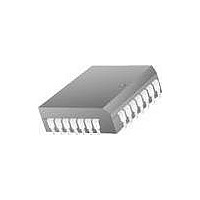ML2003CQ Fairchild Semiconductor, ML2003CQ Datasheet - Page 7

ML2003CQ
Manufacturer Part Number
ML2003CQ
Description
Linear Regulators - Standard Gain/attenuator Logarithmic
Manufacturer
Fairchild Semiconductor
Datasheet
1.ML2003CQ.pdf
(11 pages)
Specifications of ML2003CQ
Input Voltage Max
3 V
Lead Free Status / Rohs Status
Lead free / RoHS Compliant
Available stocks
Company
Part Number
Manufacturer
Quantity
Price
Company:
Part Number:
ML2003CQ
Manufacturer:
COPAL
Quantity:
5 510
PRODUCT SPECIFICATION
Functional Description
The ML2003 consists of a coarse gain stage, a fine gain
stage, an output buffer, and a serial/parallel digital interface.
Gain Stages
The analog input, V
the coarse gain stage. The coarse gain stage has a gain range
of 0 to 22.5dB in 1.5dB steps.
The fine gain stage is cascaded onto the coarse section. The
fine gain stage has a gain range of 0 to 1.5dB in 0.1dB steps.
In addition, both sections can be programmed for either gain
or attenuation, thus doubling the effective gain range.
The logarithmic steps in each gain stage are generated by
placing the input signal across a resistor string of 16 series
resistors. Analog switches allow the voltage to be tapped
from the resistor string at 16 points. The resistors are sized
such that each output voltage is at the proper logarithimic
ratio relative to the input signal at the top of the string. Atten-
uation is implemented by using the resistor string as a simple
voltage divider, and gain is implemented by using the resis-
tor string as a feedback resistor around an internal op amp.
Gain Settings
Since the coarse and fine gain stages are cascaded, their gains
can be summed logarithmically. Thus, any gain from –24dB to
+24dB in 0.1dB steps can be obtained by combining the
coarse and fine gain settings to yield the desired gain setting.
The relationship between the digital select bits and the corre-
sponding analog gain values is shown in Tables 1 and 2. Note
that C3-C0 selects the coarse gain, F3-F0 selects the fine gain,
and ATTEN/GAIN selects either attenuation or gain.
Output Buffer
The final analog stage is the output buffer. This amplifier has
internal gain of 1 and is designed to drive 600 ohms and
100pF loads. Thus, it is suitable for driving a telephone
hybrid circuit directly without any external amplifier.
Power Supplies
The digital section is powered between V
volts. The analog section is powered between V
and uses AGND as the reference point, or ±5 volts.
GND and AGND are totally isolated inside the device to
minimize coupling from the digital section into the analog
section. However, AGND and GND should be tied together
physically near the device and ideally close to the common
power supply ground connection.
Typically, the power supply rejection of V
analog output is greater than –60dB at 1 kHz. If decoupling
of the power supplies is still necessary in a system, V
V
REV. 1.1.1 3/19/01
SS
should be decoupled with respect to AGND.
IN
, goes directly into the op amp input in
CC
CC
and GND, or 5
and V
CC
SS
and V
CC
to the
and
SS
Powerdown Mode
A powerdown mode can be selected with pin P
P
consumption is reduced by removing power from the analog
section and forcing the analog output,V
impedance state. While the device is in powerdown mode,
the digital section is still functional and the current data
word remains stored in the latch when in serial mode.
When P
Digital Section
The ML2003 can be operated with a serial or parallel
interface. The SER/PAR pin selects the desired interface.
When SER/PAR = 1, the serial mode is selected. When
SER/PAR = 0, the parallel mode is selected. The ML2004
digital interface is serial only.
Serial Mode
Serial mode is selected by setting SER/PAR pin high. The
serial interface allows the gain settings to be set from a serial
data word.
The timing for the serial mode is shown in Figure 10. The
serial input data, SID, is loaded into a shift register on rising
edges of the shift clock, SCK. The data can be parallel
loaded into a latch when the input latch signal, LATI, is high.
The LATI pulse must occur when SCK is low. In this way,
a new data word can be loaded into the shift register without
disturbing the existing data word in the latch.
The parallel outputs of the latch control the attenuation/gain
setting. The order of the data word bits in the latch is shown
in Figure 11. Note that bit 0 is the first bit of the data word
clocked into the shift register. Tables 1 and 2 describe how
the data word programs the gain.
Table 1. Fine Gain Settings (C3-C0 = 0)
F3 F2 F1 F0
DN
0
0
0
0
0
0
0
0
1
1
1
1
1
1
1
1
= 1, the device is powered down. In this state, the power
0
0
0
0
1
1
1
1
0
0
0
0
1
1
1
1
DN
0
0
1
1
0
0
1
1
0
0
1
1
0
0
1
1
= 0, the device is in normal operation.
0
1
0
1
0
1
0
1
0
1
0
1
0
1
0
1
ATTEN/GAIN = 1 ATTEN/GAIN = 0
-1.0
-1.1
-1.2
-1.3
-1.4
-1.5
-.1
-.2
-.3
-.4
-.5
-.6
-.7
-.8
-.9
0
Ideal Gain (dB)
OUT
, to a high
ML2003, ML2004
DN
1.0
1.1
1.2
1.3
1.4
1.5
.1
.2
.3
.4
.5
.6
.7
.8
.9
0
. When
7












